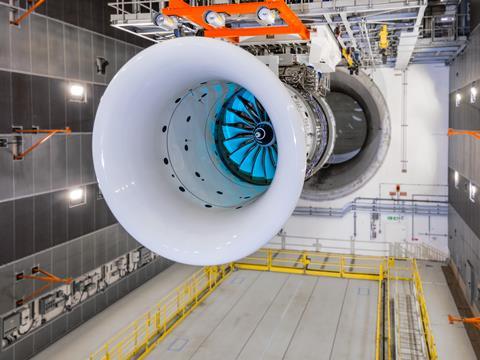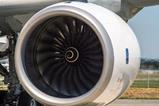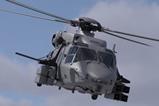Rolls-Royce has revived ambitious plans to flight test its UltraFan engine – potentially in partnership with Airbus – and will next year begin assembling a second iteration of the demonstrator, while also working to prove its suitability for single-aisle applications.
Ground tests of the initial widebody-sized UltraFan engine took place at the UK propulsion specialist’s Derby facility in 2023 during which the demonstrator accumulated around 70h of running time.

Those evaluations culminated in the engine reaching at least its maximum thrust of 85,000lb (380kN), although the UltraFan was taken “considerably higher than that”, says Simon Burr, Rolls-Royce group director of engineering.
“We are really pleased with how it ran,” he said, speaking at a pre-Farnborough air show briefing in London on 11 July.
Parts for the second demonstrator – which will incorporate “improvements over the first iteration” – have been procured “and we’ll build that engine next year”, says Burr, adding: “And then we plan to get it to fly.”
At the demonstrator programme’s launch in 2014, Rolls-Royce’s original plan was to build four engines and included flight-testing as part of its goal to take the UltraFan design to technology readiness level 6 (TRL6).
Although the programme was subsequently scaled back following Boeing’s failure to launch its New Midsize Airplane and the subsequent Covid-19 pandemic, Burr says the ambition to take the engine to flight and achieve TRL6 remains.
“We have been reshaping how we deliver that through the second part of this decade,” he adds; attaining TRL6 is targeted “by the end of this decade”.
“We are on a programme to fly that thing and we are working in lockstep with Airbus on that. We are going to fly that engine in due course.”
Burr does not provide more details on the proposed flight-test programme – presumably aboard Airbus’s A380 testbed – or its likely timing. For its part, Airbus adds only that it is ”working closely with engine manufacturers to explore and mature technology pathways for the next generation of engines. This includes working with Rolls-Royce on their UltraFan engine.”
It is unclear where in the Airbus widebody range an UltraFan engine would fit, although it could offer potential for any future re-engining of the Trent XWB-powered A350 family.
However, a likely mid-term application could be on a next-generation Airbus single-aisle as the airframer contemplates a successor to the A320neo family for service-entry in the second half of next decade.
Rolls-Royce has made no secret of its ambition to return to the narrowbody market it exited in 2012 with the sale of its interest in International Aero Engines and is clearly eyeing the Airbus opportunity with interest.
As such, Rolls-Royce is working on a separate project to ensure that the UltraFan architecture can be scaled down for narrowbody applications.
“When we talk about UltraFan…we have always said it’s scalable. We have run the big UltraFan and I’m just going to say this: we are going to prove it’s scalable,” says Burr.
He says he has already “conceptualised” a smaller version of the UltraFan, which would marry the gearbox and fan system from the existing design with the “really great” Advance2 two-spool core currently used in Rolls-Royce’s business jet engine line-up.
That process will be aided by its leadership of a Clean Aviation-backed project. Called HEAVEN, the project “will significantly develop Rolls-Royce scalable UltraFan architecture” alongside other next-generation engine technologies including hydrogen combustion and hybrid-electric systems, project documents disclose.
Rolls-Royce “proposes to significantly evolve the UltraFan design”, enabling it to meet a 20% fuel-burn reduction target for 2035 service entry.
Project HEAVEN runs until December 2026, with a follow-on effort – which would include flight tests – potentially taking place under Clean Aviation’s second phase.































